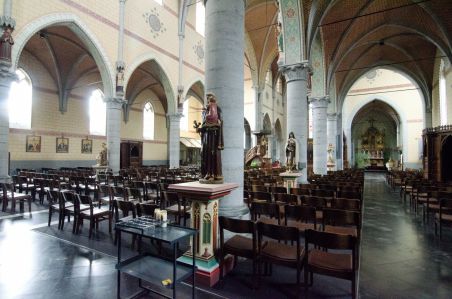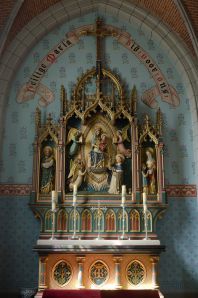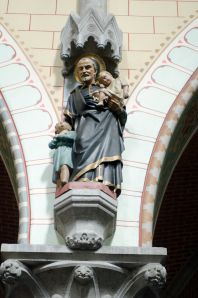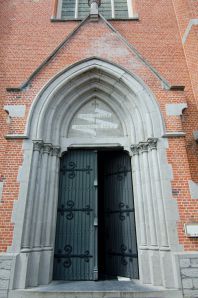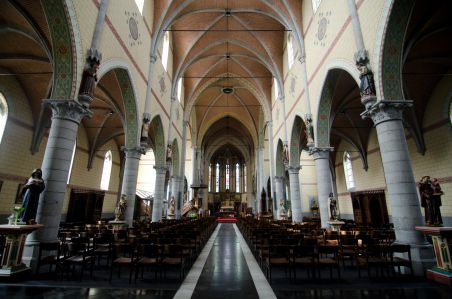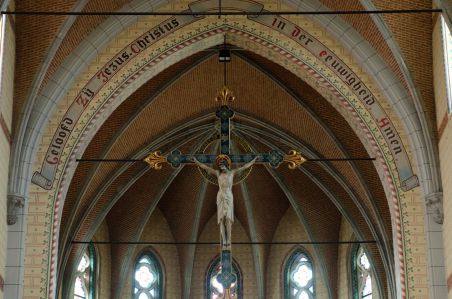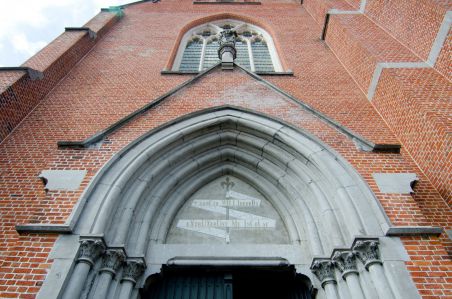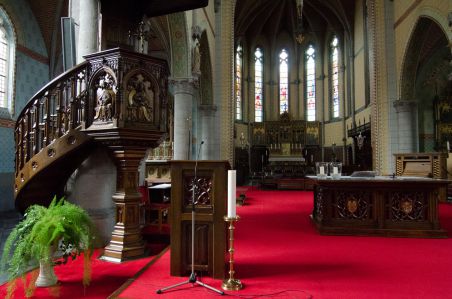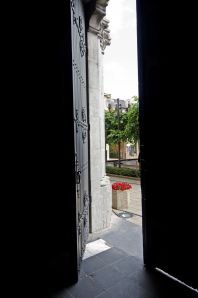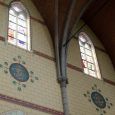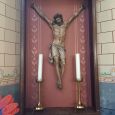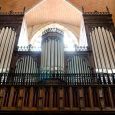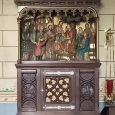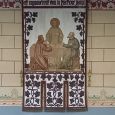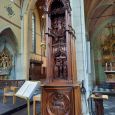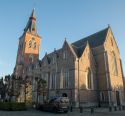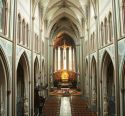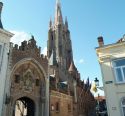Church | 1895 | Neogothic | Catholic Church




Map
Opening hours
01 January - 31 December
Mon 8.00 - 18.00
Tue 8.00 - 18.00
Wed 8.00 - 18.00
Thu 8.00 - 18.00
Fri 8.00 - 18.00
Sat 8.00 - 18.00
Sun 8.00 - 18.00
Guided tour
+32 486 73 21 10
Religious offices
Description
The church was built between 1892-1895 and replaces and older church that was demolished in 1885. This new brick building was constructed in a neo-Ghotic style. The interior was restored carefully in the 20th century and the church became a protected heritage site in 1996. The parsonage located behind the church is also protected heritage.
The building process of the current church is a story on its own. In 1843, after a significant population boom, the public felt that the old church was too small. The first plans that involved an extension were rejected. In 1877 the next set of plans comprising a completely new building turned out to be too expensive. Another set of plans created in 1881 were met with resistance. They included the demolition of the old church and the Commission for monuments and landscapes at that time was opposed to this.
However, in 1885 a permission for demolition was obtained. The construction of the new building started soon after that but was almost immediately shut down when cracks and tears in the walls started to appear. A year later this rudimentary construction was knocked down and the search for a new building site commenced. The planned location of the tower also shifted to the southeast corner of the building.
The parish prides itself on a couple of interesting decor elements: the sacrament tower, the altarpiece of the main altar, the restored Vereecken organ, the altarpiece of the week chapel and the pulpit. The neo-Ghotic painting by the brothers Buysse dates back to 1913. The stained glass was restored and the organ was also subjected to a number of restorations, one of those by Gabriel Loncke, to make it ready to play for services and concerts.
Photos
Media
Remarkable elements
Wall paintings
The paintwork is harmonious and colourful. The neo-Gothic painting by the Buyse brothers dates from 1913 and consists of a beige-coloured base with imitation joints and medallions with banderoles. As a result of this authentically preserved and restored interior, the church was listed and a certificate of 'East Flanders History' was handed over to the church factory in December 1995.
Wooden statue of Christ
Flemish-style wooden statue of Christ dating from around 1600 (Renaissance). It was probably originally hung from a cross wood in a shipyard. The statue was placed at the entrance of the funeral chapel and was hung in a neo-Gothic niche adapted to our church interior. The book panels that were processed come from our church and the above finishing is a piece of the neo-Gothic processional canopy ( of Knesselare) dated 1895 - and drawn 'Octaaf Buyse'.
Translated with www.DeepL.com/Translator
Vereeckenorgan
The Vereecken organ (romantic organ) was built in 1898 by Vreecken (organ builders Gijzegem) the brothers. It was thoroughly restored and completed between 2004 and 2006 by Jan Lapon Diksmuide. It was again festively inaugurated on 17 June 2007.
Altarpiece dedicated to the Holy Family
Neogothic polychrome statue of the bread multiplication. A valuable wooden polychrome statue was given to the church by one of the inhabitants of Knesselare (family Buysse, Klissestraat Knesselare). It was expertly incorporated into a small tabernacle in the weekly chapel.
Banner
The banner of the Emmaus Companions was originally the banner of the Guild of the Blessed Sacrament, which still exists and was created in the 17th century. It is one of the oldest objects in the church. In 1995 it was severely damaged by rain due to a leak near a window. The firm Grossé of Bruges took over the restoration.
Tabernacle
At the pillar opposite the pulpit we find an important neo-Gothic work of art. After the closure of a Jesuit church (college church) in Antwerp, we had the opportunity to give a new and correct destination to a unique work of art that shows a very pure neo-Gothic wood sculpture. In our church we see a lot of relief sculpture (semi elevated) like the rerebos of the altars and the pulpit. In contrast, the work of art from the Jesuit Church shows us real sculpture that can be counted among the best of neo-gothic art. We see two scenes: at the bottom (the most beautiful) a sculpted 'Calvary', the crucified Christ and under the cross Mary and John, and at the top 'Mary ascended to heaven'. The whole is in an imposing, beautifully sculpted niche, decorated with leaf motifs and penacles.



